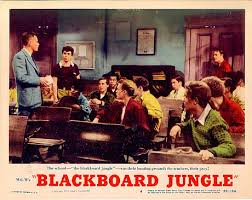The Fifties saw the end of rationing and a gradual increase in prosperity for those who, as Prime Minister MacMillan stated, “have never had it so good”. One development that stemmed from this apparent affluence was the emergence of 'youth' as a group with a defined identity and as a target for consumer goods, as young people with disposable income became an attractive proposition for those selling records, clothes and all the trappings of the teenager.
 Controversial subjects on film were accommodated in the UK under the new 'X' category, introduced in 1951and incorporating the former advisory 'H' category given to horror films. As the growth of television ownership eroded the adult/family cinema audience, films like Rock Around The Clock(1956) drew teenage audiences. Cut for U, this film caused rioting in cinemas and fuelled increasing concern about teenage criminality, although there was in fact no evidence of a teenage crime wave as suggested by the popular Press.
Controversial subjects on film were accommodated in the UK under the new 'X' category, introduced in 1951and incorporating the former advisory 'H' category given to horror films. As the growth of television ownership eroded the adult/family cinema audience, films like Rock Around The Clock(1956) drew teenage audiences. Cut for U, this film caused rioting in cinemas and fuelled increasing concern about teenage criminality, although there was in fact no evidence of a teenage crime wave as suggested by the popular Press. 
The new 'X' category, which excluded children under 16, was sufficient to contain the cynical La Ronde, Max Ophuls' 1951 film about a chain of sexual encounters. Records suggest that the film was cut, unsurprising in an era when the Board was disinclined to relinquish its role as protector of public morals, to the extent that even in 1956 dialogue cuts were made to Ingmar Bergman's Smiles of a Summer Night because the sex references were considered too risqué.
Concerns about what were then known as juvenile delinquents delayed the classification of Laslo Benedek's 1954 film, The Wild One, for thirteen years because the Board described the contents as 'a spectacle of unbridled hooliganism'. Repeated attempts were made to secure a classification, and eventually some local authorities overturned the Board's rejection, allowing local releases. The riots in English seaside towns involving Mods and Rockers (1964) were cited as providing justification for the Board's continuing objections to the film. The Board maintained its stance until 1967, when the dangers associated with the film's release were judged to be over.
Nicholas Ray's 1955 Rebel Without A Cause also ran into trouble because of its depiction of what the Board considered to be anti-social behaviour and teen violence, but substantial cuts were agreed for the film's release at 'X'. In the same year, Richard Brook's The Blackboard Jungle was submitted. The first reaction of the BBFC 's Secretary, Arthur Watkins, was to reject it, on the grounds that 'filled as it is with scenes of unbridled revolting hooliganism (it) would, if shown in this country, provoke the strongest criticism from parents...and would have the most damaging and harmful effect on...young people'. The film was withdrawn from the Venice Film Festival after pressure from the US ambassador to Italy, who felt that it presented an unflattering impression of American schools. The rejection decision was challenged by MGM, the distributor, and the film was viewed again by the Board President which resulted in another rejection, although the artistic merits of the film were acknowledged and cuts were considered. A series of negotiations then began, resulting in substantial cuts for an 'X' certificate.
1955 also saw the rejection of a very different film, The Garden of Eden, about a mother and daughter who decide to become nudists. The film only showed bare breasts and buttocks, but the film was regarded as unacceptable, the BBFC having had a long-standing policy against screen nudity, partly on the grounds that if they encouraged more nudity on screen, they would be inviting sexual exploitation. However, a large number of local authorities saw fit to overturn the BBFC decision, to the extent that in 1958, the Board was obliged to classify the film at 'A'.
The topic of drugs exercised the BBFC to a considerable degree during the decade. Devil's Weed was rejected in 1951, because the Board felt that the moral lessons about the evils of drugs use were not made sufficiently clear. In 1954, however, the Board passed L'Esclave, another film dealing with the subject of drugs, albeit with cuts.
1955 saw the submission of Otto Preminger's The Man With The Golden Arm, a story about a recovering drug addict who is lured back into his habit. The Home Office had made it known that they had no objection to films dealing with the subject of addiction, provided that drug-taking was not seen to be attractive and that the profits from dealing were not emphasised. Given this basis, the Board felt able to offer an 'X' in 1956 with cuts to details of drug-preparation and some incidental violence. It is interesting to note that while the film had a fairly smooth passage past the Board in the UK, it met with problems with the Production Code in the USA, where the theme of drugs in films was proscribed by the MPAA. The Code was amended in 1956 to allow for the treatment of narcotics as a theme. The video was later classified at '15'.
In the same year, Lee Thompson's Yield To The Night was passed uncut at 'X'. At the same time in 1956 Ruth Ellis, was the last woman to be hanged in the UK for murder, but the theme of capital punishment for women was much on the public agenda. The Examiners expressed concerns at an early stage about how such a theme might be handled, and even before the film was scripted Arthur Watson was warning the distributor that an 'X' certificate was the most likely outcome, and only if the treatment was discreet. The distributor argued strongly for an 'A' category at the script stage and the Board's examiners considered whether there was any possibility of an 'A', but felt that parents of girls aged between 12 and 16 would not endorse such a decision. The film was passed 'X' and it remains a '15' on video.
The year 1956 also saw the resignation of Arthur Watkins, who was replaced for the next two years as Secretary by John Nichols. In 1958 John Trevelyan became Board Secretary.
 At the end of the decade came Beat Girl. The Board was not impressed with the script for this film about a teenage girl who seeks to rebel against her father by hanging around with a bad crowd in Soho and considers becoming a stripper. The script was judged to be 'the product of squalid and illiterate minds' and several amendments were made before it was cut for 'X'. It is now classified '12' on video, having lost its appeal to shock.
At the end of the decade came Beat Girl. The Board was not impressed with the script for this film about a teenage girl who seeks to rebel against her father by hanging around with a bad crowd in Soho and considers becoming a stripper. The script was judged to be 'the product of squalid and illiterate minds' and several amendments were made before it was cut for 'X'. It is now classified '12' on video, having lost its appeal to shock.





No comments:
Post a Comment